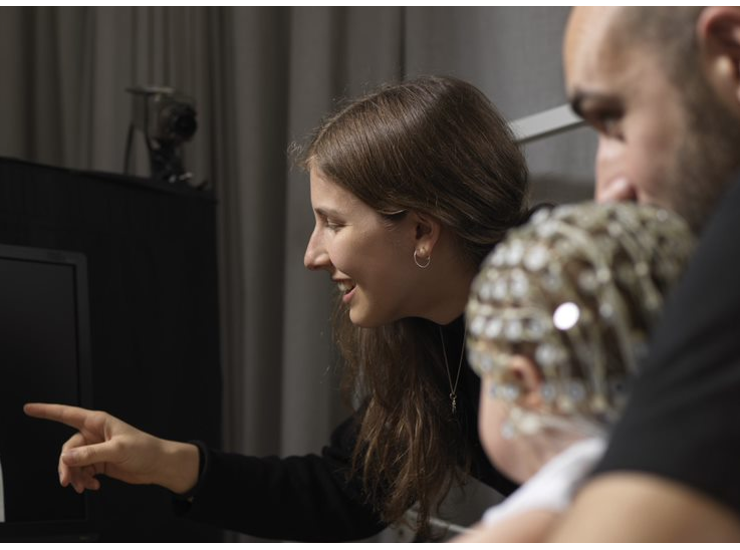
A baby's first word is an exciting milestone in their development. Within a few months, the number of words they can say will have started to grow rapidly, and eventually they will start combining words into phrases and short sentences. Although some might think of the first word as the start of a baby's language development, it doesn't happen suddenly. The Cambridge UK BabyRhythm project followed over 100 children from early infancy to late toddlerhood to understand what happens in the preverbal brain in the first year of life to lay the groundwork for language development.
In this project, we focused on how the brain encodes rhythm. Our "brain waves" - predictable rhythms created by brain cells signalling to one another - follow the rhythms of what we hear, like music and even speech. Speech has some characteristic rhythms, for example adults speaking to one another will produce about four syllables per second, and use syllabic stress (i.e. putting emphasis on a syllable) about twice per second. When we speak to babies, we instinctively use "parentese" or infant-directed speech. A key feature of infant-directed speech is that it is very rhythmic, and emphasises slower rhythms of around two beats per second. In fact, many common lullabies and nursery rhymes are built around this rhythm.
We wanted to find out if the developing brain can follow these slow rhythms, and if this is helpful for language development. In studies with older children, it has been found that difficulties with language, such as dyslexia, are related to differences in how the brain synchronises to slow rhythms in speech. Rhythms around two beats per second are particularly affected.
We found that the infant brain is especially responsive to these slow rhythms in speech. It encodes rhythms at two beats per second better than faster rhythms (including those at the rate of syllables, around four beats per second). This synchronization to slow rhythms happens as early as two months of age, meaning that long before infants begin to understand language, their brains are ready to process its rhythms. We also studied how infants synchronize their movements to these rhythms, by seeing if they could drum along to simple beats and to nursery rhymes. Although drumming in time is quite challenging for babies, by 11 months some of them could slow down their drumming to match the slower nursery rhymes.
As the infants in our study grew into toddlers, we followed up with measures of their language development. These measures included their vocabulary, phonology (perception and production of different speech sounds), and ability to communicate using gestures like pointing. The brain's ability to synchronize to slow rhythms, even at two months of age, relates to language development - particularly vocabulary size - up to two years of age. Even when presented with a talking face that made no sound, the infant brain's synchronization with the rhythm of the mouth opening and closing was related to vocabulary size at 24 months of age.
What this all means is that long before babies show signs of speaking or even understanding words, their brains are preparing for language. How the developing brain "locks on" to rhythms in speech seems to have implications for language development. Right now, we are beginning to understand the links between early brain processes and language. We hope that in the future, the link between brain rhythms and speech rhythms might provide a pathway to intervene and help children at risk of dyslexia or other language difficulties at the earliest stages of development.

